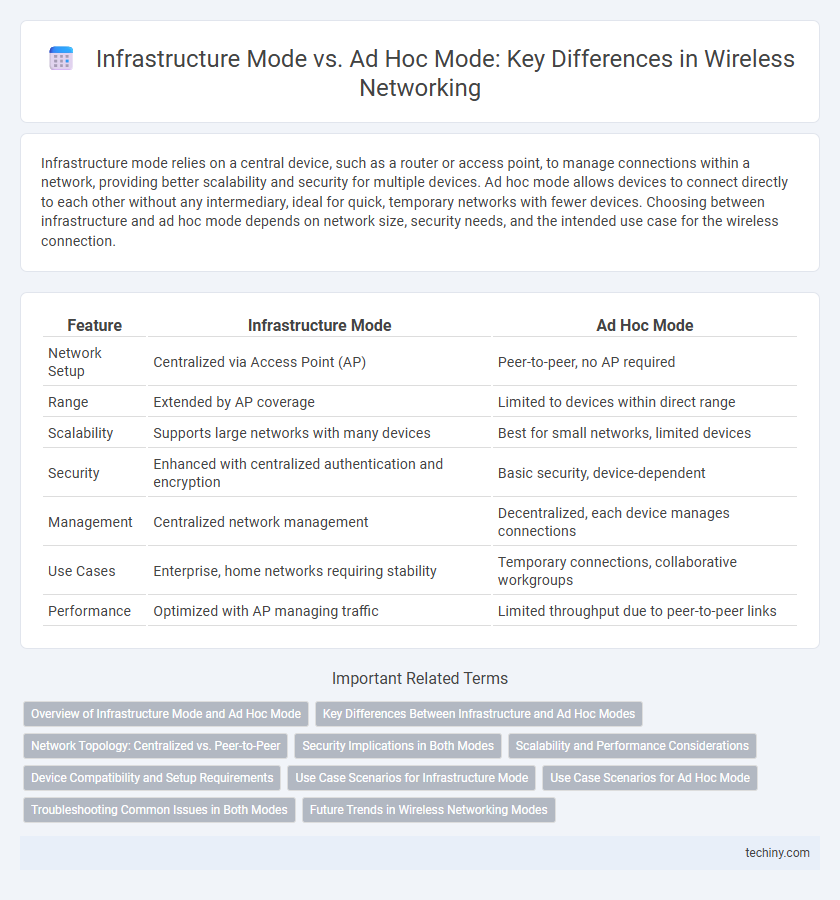Infrastructure mode relies on a central device, such as a router or access point, to manage connections within a network, providing better scalability and security for multiple devices. Ad hoc mode allows devices to connect directly to each other without any intermediary, ideal for quick, temporary networks with fewer devices. Choosing between infrastructure and ad hoc mode depends on network size, security needs, and the intended use case for the wireless connection.
Table of Comparison
| Feature | Infrastructure Mode | Ad Hoc Mode |
|---|---|---|
| Network Setup | Centralized via Access Point (AP) | Peer-to-peer, no AP required |
| Range | Extended by AP coverage | Limited to devices within direct range |
| Scalability | Supports large networks with many devices | Best for small networks, limited devices |
| Security | Enhanced with centralized authentication and encryption | Basic security, device-dependent |
| Management | Centralized network management | Decentralized, each device manages connections |
| Use Cases | Enterprise, home networks requiring stability | Temporary connections, collaborative workgroups |
| Performance | Optimized with AP managing traffic | Limited throughput due to peer-to-peer links |
Overview of Infrastructure Mode and Ad Hoc Mode
Infrastructure mode relies on a central access point to manage communication between wireless devices, enabling seamless connectivity and extended network range. Ad hoc mode creates a decentralized network where devices communicate directly without an access point, ideal for temporary or peer-to-peer connections. Infrastructure mode supports scalability and enhanced security features, while ad hoc mode offers simplicity and flexibility for small-scale networking scenarios.
Key Differences Between Infrastructure and Ad Hoc Modes
Infrastructure mode relies on a centralized access point to manage communication between devices, enhancing network stability and scalability, while ad hoc mode enables direct device-to-device connections without a central router, supporting flexible and temporary networks. Infrastructure mode supports better security protocols and wider coverage through access points, whereas ad hoc mode is limited to peer-to-peer communication with simpler setup but weaker security. Network configuration in infrastructure mode is typically managed by network administrators, contrasting with the spontaneous and decentralized nature of ad hoc networks suitable for small or impromptu environments.
Network Topology: Centralized vs. Peer-to-Peer
Infrastructure mode utilizes a centralized network topology where wireless devices connect through an access point acting as a central hub, optimizing traffic management and security. Ad hoc mode employs a peer-to-peer topology, enabling direct communication between devices without intermediary hardware, suitable for temporary or small networks. Centralized networks in infrastructure mode provide scalability and easier administration, while peer-to-peer networks offer flexibility and rapid deployment.
Security Implications in Both Modes
Infrastructure mode offers enhanced security through centralized control by the access point, enabling robust encryption protocols like WPA3 and easier implementation of network policies. In contrast, ad hoc mode lacks a central authority, making it more vulnerable to unauthorized access and data interception due to peer-to-peer connections with limited security enforcement. Network administrators often favor infrastructure mode for sensitive environments to ensure consistent authentication and monitoring.
Scalability and Performance Considerations
Infrastructure mode supports better scalability by managing multiple devices through a centralized access point, ensuring efficient traffic routing and reduced collisions for improved network performance. Ad hoc mode, designed for direct device-to-device communication, faces limitations in scalability due to increased contention and interference as the number of nodes grows. Performance in infrastructure mode typically surpasses ad hoc mode in larger networks because centralized control optimizes bandwidth allocation and minimizes communication overhead.
Device Compatibility and Setup Requirements
Infrastructure mode supports a wide range of devices by connecting them through a central access point, ensuring compatibility with smartphones, laptops, printers, and IoT devices. Ad hoc mode requires each device to have compatible wireless protocols and direct peer-to-peer communication capabilities, limiting its use to scenarios with fewer devices. Setting up infrastructure mode involves configuring an access point and network settings, while ad hoc mode demands manual device connections without centralized management.
Use Case Scenarios for Infrastructure Mode
Infrastructure Mode is ideal for enterprise environments where centralized control, security, and scalability are crucial, such as corporate offices and campus networks. It enables seamless connectivity through access points that manage device authentication and traffic, supporting large numbers of clients efficiently. This mode is preferred when reliable internet access and network management features like monitoring and bandwidth control are essential.
Use Case Scenarios for Ad Hoc Mode
Ad Hoc Mode is ideal for temporary, peer-to-peer wireless networks where devices connect directly without relying on a central access point, such as in spontaneous file sharing, gaming sessions, or emergency response situations. This mode supports flexible, decentralized communication in environments lacking pre-existing infrastructure, enabling quick setup and dynamic networking. It is particularly useful in remote or mobile scenarios requiring immediate connectivity without the need for permanent network hardware.
Troubleshooting Common Issues in Both Modes
Common issues in Infrastructure Mode include connectivity drops due to faulty access points or incorrect IP configurations, often resolved by verifying SSID settings and DHCP server functionality. In Ad Hoc Mode, frequent problems stem from peer-to-peer communication failures and inconsistent signal strength, typically addressed by ensuring matching channel settings and confirming compatible wireless adapter drivers. Network administrators should use diagnostic tools like ping tests and wireless analyzers to identify interference and authenticate device associations in both modes.
Future Trends in Wireless Networking Modes
Infrastructure mode dominates current wireless networking with centralized access points enhancing security and scalability, while ad hoc mode remains vital for direct device-to-device communication in decentralized scenarios. Future trends emphasize hybrid models integrating AI-driven optimization and edge computing to seamlessly switch between infrastructure and ad hoc modes for improved network resilience and efficiency. Advances in 5G and beyond will enable dynamic mode selection based on real-time network conditions, boosting connectivity in smart cities, IoT ecosystems, and autonomous systems.
Infrastructure Mode vs Ad Hoc Mode Infographic

 techiny.com
techiny.com